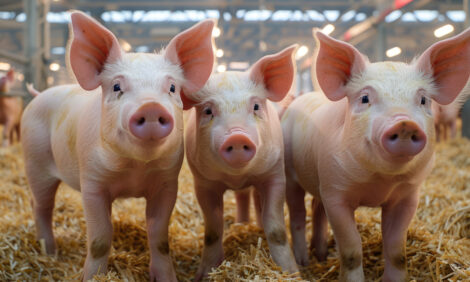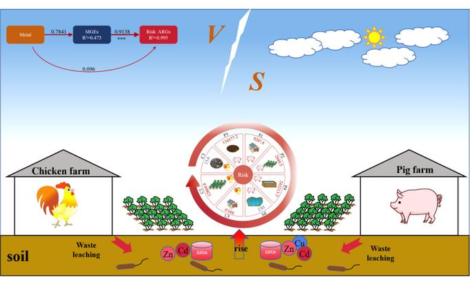



Quantitative Selection for Piglet Survival as A Safe Way to Reduce the Cost of Weaners
By Egbert Frank Knol - In this paper, first presented at the 2003 Banff Pork Seminar, trait piglet survival is explored using quantitative methods, searching for genetic variation (Knol, 2001) and for biological explanations for possible genetic differences in piglet survival (Leenhouwers, 2001).Introduction
Genetic variation between animals exists. There is no doubt about that. Variation in a trait, e.g. litter size, is caused by variation in a number of genes influencing the underlying processes of litter size such as ovulation rate, variation in elongation, and prenatal survival. Geneticists nowadays have two powerful toolkits available to choose individuals with the right alleles. One is the quantitative toolkit and the other the molecular one. There are at least three reasons to try to improve piglet survival.
Selection for increased litter size is successful in most breeding programs. The correlation between litter size and mortality is positive. Larger litters result, on average, in higher mortality.
Larger litters increase the necessity of (cross) fostering in a time that farm size increases and input of labour per sow decreases. Therefore, more labour is needed, but less is offered.
Beginning in Western Europe, concern for animal welfare is gradually accepted in a growing number of countries.
The result of this concern can be a government mandate for an increase in
lactation days, a decrease in the possibility of mixing piglets, and an increase in
space allowance for sows, piglets and finishers.
In general, it would be helpful for the economy of pork production if both sow
and piglet could survive with little human intervention and still allow for an
increase in litter size.
An Approach to Address Piglet Survival Genetically and Biologically Definition of survival and of genetic effects
Losses in litter size occur in different phases, until weaning these are:
- Uterine survival (complement of number of mummified)
- Farrowing survival (complement of number of stillbirths)
- Preweaning survival (complement of number of lactation losses)
In this paper piglet survival is defined mathematically as the proportion of
piglets surviving from late gestation to weaning: (# weaned/total # born). In
many countries this is, on average, 80.3% (still born 7.4%, preweaning losses
12.8%). Uterine survival is excluded, as is survival after weaning.
Important genotypes for survival of a piglet are its own set of genes, the set of
genes of the sow nursing it, and the set of genes of the sow that gave birth to
the piglet. The latter is responsible for the prenatal environment; in genetic
terms this effect is called the maternal effect. The effect of the genes of the
piglet will be referred to as vitality and the effect of the nurse sow as mothering
ability. It should be noted that in most cases the biological mother is also the
sow nursing the piglets.
Quantitative selection for piglet survival
To explore this trait birth weights, fostering and survival observations were
taken on individual piglets on 32 TOPIGS nucleus, multiplication and piglet
production farms in different countries and under different health conditions.
Full pedigrees for both sow and piglet were available for some 600,000 piglets.
Results
Genetic analysis
Genetic analysis yielded heritabilities of 0.02 for vitality on a piglet basis and
0.07 for mothering ability (Knol et al., 2002). A heritability of 0.02 is extremely low, but still promising because genetic variation is considerable and because a large number of observations are available per parent. Simulation (Table 1) showed that single trait selection for litter size will reduce piglet survival, as is expected. Simultaneous selection for litter size and birth weight will increase birth weight dramatically, but will not increase survival nor increase litter size.
Eight years of selection on an index of litter size and piglet survival will increase
litter size total born from 12.3 to 12.8 piglets per litter and at the same time
increase survival from 80.3% to 84.2%.
| Table 1: Simulation response of 8 years of selection on (1) only litter size (LS), (2) an index of litter size and birth weight (BW) or (3) an index of litter size and survival. | ||||
| 2002 | 2010 | |||
| Litter size | LS + BW | LS + survival | ||
| Litter index | 2.32 | 2.35 | 2.35 | 2.35 |
| Total born (LS) | 12.20 | 13.70 | 12.26 | 12.80 |
| Live born | 11.30 | 12.72 | 11.22 | 12.11 |
| Stillborn | 0.90 | 0.98 | 1.04 | 0.69 |
| Piglet survival | 80.3 | 78.3 | 79.8 | 84.2 |
| Weaned/litter | 9.80 | 10.72 | 9.79 | 10.78 |
| Weaned/sow/year | 22.8 | 25.2 | 23.0 | 25.3 |
| Ave. Birth weight (BW) | 1.45 | 1.34 | 1.74 | 1.39 |
| Variation in BW | 280 | 280 | 310 | 268 |
| Litter weight | 17.7 | 18.4 | 21.3 | 17.8 |
Proof
200 gestating sows were assigned to one of two groups based on the Expected Breeding Value for Piglet Survival (EBVPS) of their offspring; difference between the two groups was 4.0% expected survival. Realized difference was 3.97%. It was very interesting to note that the groups did not differ in litter size or average birth weight. They did differ, however, in within litter variation in birth weight and litter weight at birth. Both were significantly lower for the high survival group.
Mode of Action
Since genetic differences in piglet survival can be predicted accurately, high/low EBVPS sampling can be done to investigate the underlying biological processes. A high and low EBVPS group were formed of 25 gilts each, inseminated with semen of high and low EBVPS boars, respectively, and piglets were delivered with caesarean section at day 111 of gestation (Leenhouwers et al, 2002). All piglets were sacrificed, dissected, and analyzed. Individual placentas were available.
Differences between high and low EBVPS groups were found. For the high EBVPS group, the placental weight was lower. Within the litter, the placental weight variation was more uniform. The liver, stomach, and small intestinal weights were higher. The glycogen content of the liver and muscles was higher and blood cortisol level was significantly higher. The hypothesis is that selection for increased survival acts through an increase in cortisol, which plays an important role in the preparation of the piglet for the birth process. It enhances lung maturation and glycogen synthesis, both vital processes for early neonatal survival.
Genetic Cost of Selection for Piglet Survival
Survivability is only one of many traits important for efficient pork production. It is important to know the relationships between these traits. A statistical analysis revealed significant moderate genetic correlations (0.4-0.5) between piglet survival on one side and feed intake, daily gain, and protein and fat accretion on the other side. This indicates that selection for increased survival will definitely influence finishing traits, but also that intense selection on leanness will negatively affect piglet survival.
Discussion
Quantitative Selection
Almost all economically important traits can be improved genetically. The main
concern is the correlated traits. At what costs can genetic improvement be
generated. With a quantitative approach, observations are taken on relevant
animals under diverse environments, correlations between traits and genotype
environment interactions are assessed, and predictions on expected genetic
change are made. Even for a trait with a very low heritability, such as piglet
survival, considerable genetic progress can be realized. A proper analysis of
the data can increase the biological understanding of the trait. From this genetic
and biological understanding a search for important genes can begin.
Survival and Birth Weight
The phenotypic relation between birth weight and survival is very clear. In every
farrowing room it is obvious that the heavier piglets have much better survival
chances than their smaller littermates. The genetic relationship, however, is
very low. Selection for increased birth weight will not lead to a clear increase in
survival.
Differences between lines and breeds can provide some insight. The main
example is the Meishan, one of the Chinese breeds. Meishan piglets have an
average birth weight below 1 kg, but a survival rate similar or higher than Large
White piglets with an average birth weight of 1.4 kg. In Figure 1 weight survival
curves are drawn for the high/low EBVPS piglets discussed above. Survival
increases especially for the lighter piglets. It is interesting to note the absence
of the very heavy piglets in the high EBVPS group, indicating that uniformity
increases through the loss of heavy piglets instead of through the loss of small
piglets.

Survival and Fatness
The genetic correlation between survival and fatness is 0.5, which ismoderate
and significant. The Meishan breed has strong piglets, especially considering
the birth weight, and Meishan animals are very fat. McKay (1993) selected for
increased lean tissue daily gain and found a correlated decrease in preweaning survival. Selection for lean tissue daily gain will increase mature body size,
delay puberty and possibly delay early development somewhat. If gestation
length is fixed, piglets will gradually become more premature at farrowing with
negative consequences for later survival.
Survival and Feed Intake
The genetic correlation between survival and feed intake is of the same
magnitude as with fatness and probably is the driving factor. Selection for
increased survival will result in piglets with a larger stomach and larger small
intestines (see Mode of Action in Results section), thus preparing for later
increased feed intake. Feed intake itself has a heritability of 0.30 and is both a
difficult and an optimum trait. It is difficult because feed intake for finishers is,
on average, too low for young animals and too high for animals approaching
the end of finishing. Feed intake should be higher during hot weather and
sometimes lower in milder conditions. Feed intake for high producing sows
should be high during lactation, but appetite low through gestation (high
satiety). Feed intake through finishing should be high enough to allow for
maximum protein deposition, but low enough to keep fatness levels acceptable.
Survival and Mothering Ability
Genetic variation in mothering ability is at least as promising as genetic
variation in vitality. Biological mechanisms are being unravelled, but are left
undiscussed here.
Conclusion
Piglet survival is heritable. Genetic selection for birth weight will not, or will in only a very limited way, increase survival. Selection on an index of litter size and piglet survival will lead to considerable progress in terms of piglets weaned per sow per year, through a small increase in litter size, a considerable increase in survival, and through lighter more uniform piglets. It will result in a more balanced, less labour demanding production structure with less pressure on the sow.
References
Knol, E.F. (2001) Genetic aspects of piglet survival. PhD thesis. Wageningen University, ISBN 90-5808-418-3.Knol, E.F., B.J. Ducro, J.A.M. van Arendonk, and T. van der Lende (2002) Direct, maternal and nurse sow genetic effects on farrowing, preweaning, and total piglet survival. Livestock Production Science, 73, 153-164.
Leenhouwers, J.I. (2001) Biological aspects of genetic differences in piglet survival. PhD Thesis. Wageningen University, ISBN 90-5808-517-1.
Leenhouwers, J.I., Knol, E.F., P.N. de Groot, H. Vos, H., and T. van der Lende. (2002) Fetal development in the pig in relation to genetic merit for piglet survival. Journal of Animal Science, J. Anim. Sci. 80, 1759-1770.
McKay, R.M. (1993) Preweaning losses of piglets as a result of index selection for reduced backfat thickness and increased growth rate. Canadian Journal of Animal Science, 73, 437-442.
To read the paper Click Here (PDF Format)
Source: Paper presented at the Banff Pork Seminar - January 2003, published September 2003










